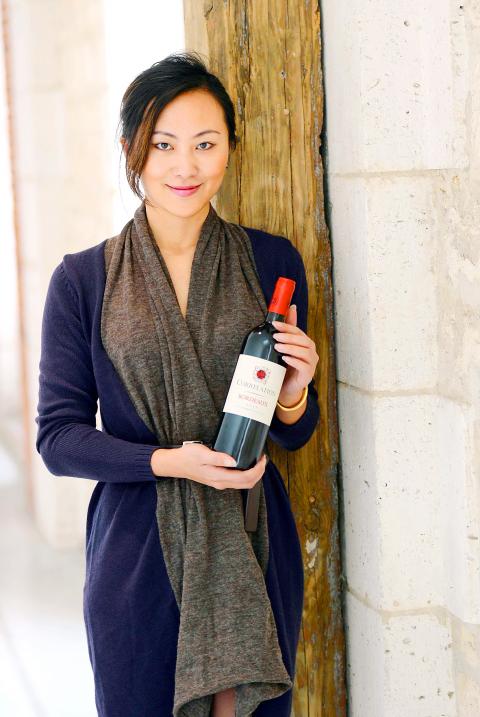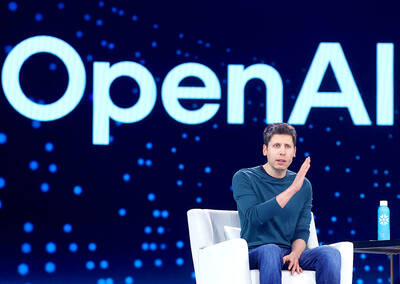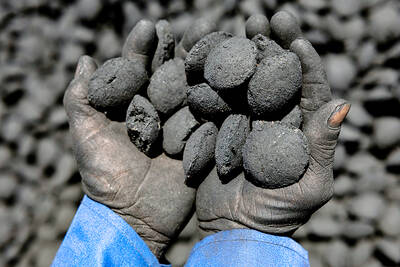Chinese investors now rival the French in buying vineyards in Bordeaux: a sign both of the region’s global prestige and China’s seemingly unquenchable thirst for wine, according to local property agencies and industry associations.
More than 100 properties in France’s southwest wine-producing area are today owned by Chinese tycoons looking to diversify fortunes built upon real estate, jewelry, industry or tourism holdings.
“The biggest buyers are Chinese and French, with each accounting for around a third of the market,” said Karin Maxwell, of Maxwell-Storrie-Baynes, a leading luxury real-estate agency in the region.

Photo: AFP
Although most of the Chinese owners stay discreet, French wine industry groups are publicly welcoming the new money flowing in.
“It’s reassuring. These purchases lift the profile of the Bordeaux brand and have advanced the vineyard property market, even if there are still vineyards for sale,” said Bernard Farges, head of the CIVB Bordeaux wine growers’ association.
So far, the Chinese own just 1.5 percent of the 7,000 vineyards in the Bordeaux region, but they started their spree just six years ago, and the last three of those years have seen sustained interest with more than two dozen properties snapped up annually.
One name dominates the list of Chinese arrivals: Qu Naijie (曲乃杰), an industrialist with net worth estimated at US$800 million who comes from sea transport and theme parks, and owns nearly 30 Bordeaux vineyards.
Part of the appeal for the Chinese is the status that comes with possessing a noble French chateau as part of their wine-growing property. The chateaux with old towers, extensive cellars, symmetrical architecture and carefully tended gardens are especially sought after.
However, the business potential is the key consideration.
China is the biggest consumer of red wine in the world and remains the top export market for Bordeaux, buying 60 million bottles last year.
Heady profits on the back of record sales continued until 2013. Then last year all Bordeaux producers — the Chinese included — faced a sharp dip, with sales declining by 17.5 percent and a 9 percent reduction in volume moved.
The slide was imputable to fragile economic growth, an official Chinese crackdown on signs of conspicuous consumption, competition from wine producers in Australia, South Africa, Chile and the US — and savvier wine-buyers abroad.
“Consumers are no longer willing to buy without checking out prices, and the Internet plays a big role in that,” said Yiping Cai, founder of a Bordeaux wine export company for China called La Selection.
With margins falling, Bordeaux’s new Chinese owners are aiming to introduce industrial efficiency and economies of scale to vineyards that used to be small, family-run affairs.
Most of the properties they have pocketed do not make top-of-line grand cru wines, but instead produce relatively unknown labels at the cheaper end of the market. Yet, crucially, they all boast the French government-regulated AOC Bordeaux label that authenticates them as genuine Bordeaux wine: a valuable reputation in a crowded marketplace.
Bordeaux is “a brand leader in the world and thus easier to sell,” said Yannick Evenou, who runs several vineyards for a major Chinese investor, Frank Yu.
Yu and the other Chinese investors are spending big to bring several properties together, each generally worth between 5 million and 15 million euros (US$5.41 million and US$16.23 million ). They then do away with traditional techniques to use technology to handle big volumes aimed for export.
While the changes wrought by the Chinese to Bordeaux production might raise some purists’ eyebrows, those in the region note that foreigners have always brought innovation with them.
“Bordeaux was built up over centuries with foreign investors: first the English, then the Dutch, the Belgians, the Japanese, and today, the Chinese,” said Laurent Gapenne, of the Bordeaux fine wines federation.
“Everybody is overjoyed that the Chinese are interested in wine growing. This proves that Bordeaux retains its predominance over the others,” he added.

DIVIDED VIEWS: Although the Fed agreed on holding rates steady, some officials see no rate cuts for this year, while 10 policymakers foresee two or more cuts There are a lot of unknowns about the outlook for the economy and interest rates, but US Federal Reserve Chair Jerome Powell signaled at least one thing seems certain: Higher prices are coming. Fed policymakers voted unanimously to hold interest rates steady at a range of 4.25 percent to 4.50 percent for a fourth straight meeting on Wednesday, as they await clarity on whether tariffs would leave a one-time or more lasting mark on inflation. Powell said it is still unclear how much of the bill would fall on the shoulders of consumers, but he expects to learn more about tariffs

NOT JUSTIFIED: The bank’s governor said there would only be a rate cut if inflation falls below 1.5% and economic conditions deteriorate, which have not been detected The central bank yesterday kept its key interest rates unchanged for a fifth consecutive quarter, aligning with market expectations, while slightly lowering its inflation outlook amid signs of cooling price pressures. The move came after the US Federal Reserve held rates steady overnight, despite pressure from US President Donald Trump to cut borrowing costs. Central bank board members unanimously voted to maintain the discount rate at 2 percent, the secured loan rate at 2.375 percent and the overnight lending rate at 4.25 percent. “We consider the policy decision appropriate, although it suggests tightening leaning after factoring in slackening inflation and stable GDP growth,”

Meta Platforms Inc offered US$100 million bonuses to OpenAI employees in an unsuccessful bid to poach the ChatGPT maker’s talent and strengthen its own generative artificial intelligence (AI) teams, OpenAI CEO Sam Altman has said. Facebook’s parent company — a competitor of OpenAI — also offered “giant” annual salaries exceeding US$100 million to OpenAI staffers, Altman said in an interview on the Uncapped with Jack Altman podcast released on Tuesday. “It is crazy,” Sam Altman told his brother Jack in the interview. “I’m really happy that at least so far none of our best people have decided to take them

As they zigzagged from one machine to another in the searing African sun, the workers were covered in black soot. However, the charcoal they were making is known as “green,” and backers hope it can save impoverished Chad from rampant deforestation. Chad, a vast, landlocked country of 19 million people perched at the crossroads of north and central Africa, is steadily turning to desert. It has lost more than 90 percent of its forest cover since the 1970s, hit by climate change and overexploitation of trees for household uses such as cooking, officials say. “Green charcoal” aims to protect what